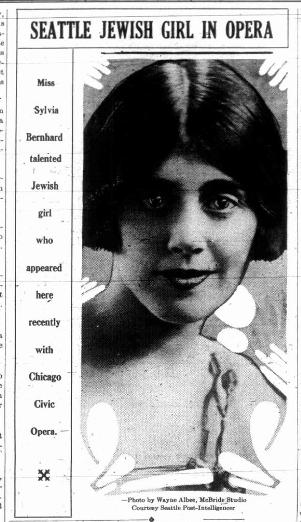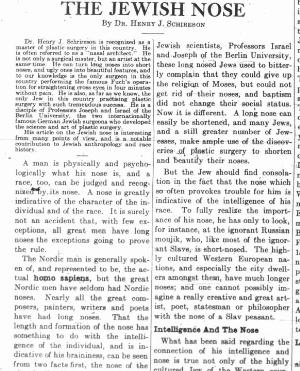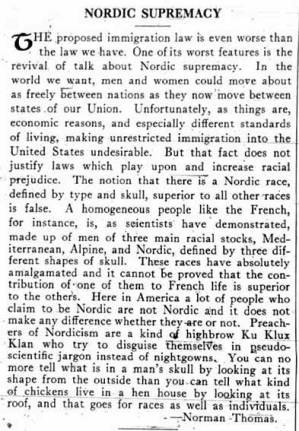Abstract: Calling itself “the Voice of Jewish Washington,” The Jewish Transcript has served the Jewish community for more than eighty years. This essay explores the very early history of the weekly newspaper. Today the newspaper publishes under the name: Jewish Transcript News.
On March 6th, 1924, Herman Horowitz printed the first edition of The Jewish Transcript. Horowitz dedicated the newspaper to the local Jewish population, as evidenced by its subtitle: “A Weekly Newspaper Devoted to the Jewry of the Pacific Northwest” on each edition. Throughout its first two years in publication the newspaper expounded on many different subjects of importance to the American Jewish population. According to Horowitz, the Pacific Northwest’s Jewish population needed to retain its cultural identity. Thus, the overall purpose of The Jewish Transcript was to reinforce the importance and significance of Jews’ distinct physical characteristics, the education of the Jewish youth, and maintenance of religious ideals. The paper also expressed the population’s persistent voice in the struggle for equality. Oftentimes, the paper communicated the struggle to keep this identity and push for equality in the face of dreadful anti-Semitism both locally and abroad.
The first edition of The Jewish Transcript included an insert written by Horowitz describing his concerns, motivations, and intentions for the newspaper. Horowitz conveyed his apprehension about founding such a newspaper, writing, “At first, I absolutely opposed the idea as I did not believe that sectarian as well as racial differences should be kept alive and I then sincerely believed that a newspaper or magazine representing and expounding a particular creed or race would tend to exaggerate those differences and would not be helpful to either the spread of Americanism or to keep alive the proper spirit of Judaism.”1 Apprehensive to endorse or promote a particular ethnic community, Horowitz expressed fear the paper might stand as a violation of the American sense of inclusiveness for all people. Not only could the paper fail to benefit those involved, but he believed such a stand had the potential to further Jews’ exclusiveness from the general body of American citizens. This suggests the publisher was optimistic about the integration of the Jewish population into American culture and hoped to establish Jews’ equality with all other people.
However, Horowitz’ statement further explained a shift in his thinking about integration. “During the last ten years,” he suggested, “conditions have changed.” Although the Jew had once been “encouraged in his effort to become thoroughly Americanized…, [t]oday much is being done to discourage him.” Unlike the encouragement of an earlier time, new anti-Semitic sentiments and persecution convinced Horowitz that “the Jew must organize, not for aggression but for self-protection.” Given these conditions, he encouraged community organization and hoped the newspaper would stand as a means of “inter-communication” to convey the Jewish “ideas, his ideals, his aspirations, and his principles.” Horowitz also explained that the purpose of The Jewish Transcript was to “advocate the highest ideals of Judaism, linked with the most strenuous Americanism.”2 Horowitz encouraged his audience to hold onto their “Jewish” identity, while still proclaiming their fully “American” identity. This suggests the publisher saw a “Jewish” identity as separate, but not mutually exclusive to an “American” identity. Horowitz appeared to strive for a blending of the two identities as the best path for the Americanization of the Jewish-American.
Horowitz explained that his newspaper would include both local and worldwide news concerning anything of Jewish interest as well as things of national importance. Although Horowitz provided a great deal of the material for the newspaper, as a significant outlet for Jewish news, many different groups and authors used the paper as a conduit for reaching a wide audience within the community. The Jewish Transcript reprinted the texts of speeches from various Jewish religious leaders and regularly featured the work of Jewish arts and media critics.
Throughout its first two years, the newspaper focused heavily on the theme of a distinct “Jewish” identity, particularly the connections between “Jewish” physical appearance and identity. The form of facial structure was widely discussed in articles that appeared in the The Jewish Transcript. An article on “The Jewish Nose” by Dr. Schireson addressed the idea that the Jewish population has a very distinct facial structure that sets them apart from the surrounding peoples, particularly in the nose. Dr. Schireson, a prominent plastic surgeon of the time, suggested the “outstanding characteristics” of the Jewish people “are the bony prominence of the face, square of the projecting jaw, high, thick, strait or hooked nose, heavy eyebrows, and high cheekbones.” But most of all, this surgeon argued, the Jew’s “long nose is admitted to be his most striking characteristic.” As Dr. Schireson observed, his Jewish clients were “anxious not to be recognized as a Jew” and “deplored” their “racial nose.” Many hoped to use the “discoveries of plastic surgery to shorten and beautify their noses.” Yet, arguing for racial pride, as Schireson proposed, the long nose of the Jewish people was indicative of the Jewish people’s extreme intelligence. As Dr. Schireson wrote, “The Jew has reason to be proud of his distinctive racial characteristic, for it is, always has been, and always will be, indicative of his superior intelligence, mature intellectuality, of steadfastness and will-power.”3 Not only did the author argue for the absolutely unique facial structure of the Jewish people, but also that Jewish people were smarter, more mature, and stronger than the average person.
This manner of defining a certain people by facial characteristics was not new. Often, media images portrayed a specific group with certain facial constructs. Usually in these images, features were exaggerated, and used as a tool of humiliation by the dominant culture. Thomas Nast, a prominent political cartoonist of the 19th century, frequently employed this tactic. In Nast’s political cartoons, he famously portrayed the Irish people as wild, drunken characters with ape-like faces. The “Jewish nose” idea served the same purpose by stereotyping a people by their facial composition. In pride rather than spite, Schireson proposed that a facial type conveyed the superior identity of the Jewish population.
Education of the Jewish youth also appeared multiple times in The Jewish Transcript as something essential to the existence and further development of the Jewish identity in the Pacific Northwest. In the paper’s mission statement, Horowitz declared, “It shall be the aim of The Jewish Transcript to inculcate and develop in the younger generation an ardent interest in Judaism, Jewish history and modern Jewish problems.”4 In line with Horowitz’ belief, the newspaper featured many articles outlining the need for Jewish education. As one article entitled “The Problem of Jewish Education in America” contended, “our children must be imbued with a spirit of devotion to Judaism to resist the forces that might seek to break the hand which unifies them.” As the article explained, “The American Jewish child is imbued with so many American ideals and ideas that he naturally places the Hebrew school and its teachings in an inferior category.”5 To withstand the blows of anti-Semitism and prevent the erosion of Jewish faith, articles in The Jewish Transcript made an urgent call for the education of the younger generation. In addition to their compulsory public education, the author recommended a program of religious education, centered on the acquisition of the Hebrew language and readings in the sacred scripture of the Torah. The only way to “command the best energies of the child,” the article continued, was through the formation of a school with the “traditional tongue of the Jews; namely Hebrew” along with “the teachings of Israel’s leading ideas and ideals.” For the Jewish population to thrive, the author argued, “Let the Jewry of America look to its future and begin with the youth.”6
While many of the contributors to The Jewish Transcript hoped to highlight the connections between Jewish identity and physical characteristics or education, others argued that Jewish culture could only be maintained through religious practice. As one article suggested, “Judaism is the vital possession of Jewry. Take away the religious faith from any people, and you take away all that matters.”7 In addition to “kosher” eating rules and the observance of “Sabbath,” many articles argued that religious practices were essential in the preservation of the Jewish identity. As one article suggested, “the Jewish faith is based on the Mosaic Law, the ten commandments,” and the Jewish refusal to “accept a trinity.”8 These laws, another author argued, set Jews apart as the “chosen people of God- a people chosen to be a blessing to all nations on earth…we are the people whom God chose from among all the peoples.”9 Although statements of religious superiority were perhaps not unanimous, contributors to the newspaper commonly stressed the significance of faith, history, and religious practice to Jews’ cultural distinctiveness.
In addition to preserving a distinct Jewish racial or ethnic identity, contributors to _The Jewish Transcript_consistently refuted claims of Jewish inferiority and touted the accomplishments of Jewish scholars. As a number of authors argued, Jews had productively contributed to American society, and therefore, deserved equal standing. The paper regularly featured articles about the accomplishments of Jewish intellectuals, artists, and scientists to prove the importance of Jews to society. For example, the Chairman of the B.B Educational Committee Mark M. Litchman authored an article entitled, “Contributions of Jews to Human Progress,” which featured the work of Jewish people. As he suggested, “Once the knowledge is given to the Jew that his race has produced great historical figures in all divisions of human progress he will have good cause to be very proud of his racial and religious heritage.”10 Each subsequent edition featured a column dedicated to the outstanding contributions of Jews in the areas of religious and academic thought. Two articles discussed the Jew’s contribution to religion’s perception of “monotheism,” and “what polytheism is”.11 Other articles focused on the Jew’s contribution to the fields of astronomy 12, economics 13, biology 14, and law.15 Other articles praised local Jewish celebrities for their role in local plays, operas, and politics. The regularity and prominence of these articles suggest the paper hoped to refute arguments of Jewish inferiority. Moreover, by pointing out the importance of Jewish contributions, the authors made an argument for equal standing in American society.
Local and international Anti-Semitism was also a common theme in the paper. As one article suggested, “wherever the Jews are fated to suffer, the suffering affects the whole of Jewry.”16 Given the universality of anti-Semitism, the international Jewish population needed to stayed connected and bound by a common faith in the face of constant persecution. According to another author, the American Jew as well as the international Jew, defined themselves as a people that have suffered historically and still suffers at their present time. As this author suggested, “For the Jews have suffered…the outstanding fact of Jewish history is the struggle of a scattered people for survival…both material and spiritual, a struggle which maintained by means of a supreme faith which kept this people intact.”17 Many of the Jewish contributors to The Jewish Transcript felt the Jewish people were destined to suffer anti-Semitism as their ancestors suffered for years before them.
Possible theories about the motivation for this hatred of the Jewish people in America appeared multiple times throughout the first two years of The Jewish Transcript. Some argued that “Anti-Semites in our day and age advance several reasons…some say that the Jews are an inferior race, some say they are a disturbing factor in society…(or) that they control the economic affairs of the world and use their power only to satisfy their own needs.”18 This author argued the Jewish population may be seen as a lesser civilization by their persecutors, or one with too much power and not enough control. Other possible theories about the motivation for anti-Semitism recorded in the newspaper include the theological standpoint of “the supposed killing of Christ by Jews.”19 According to this author, the Christian faith’s claim that Jews killed their divine Christ kindled the hatred of the surrounding population as well. Almost every issue throughout the first two years of The Jewish Transcript included some account of wrong-doing toward a Jewish person or population. This appears to convey the previously discussed deep-set desire of the Jewish population to educate the Jewish people about Jewish discrimination in order to further the cause of pulling the Jewish population of the Pacific Northwest closer together to withstand their own struggles.
The Jewish Transcript represented the Pacific Northwest Jewish people in a challenging, but essential struggle for the retention of their Jewish cultural identity in America. Balancing Americanization and cultural retention, Herman Horowitz hoped to maintain a distinct Jewish religious and cultural community. At the same time, the paper made a strong argument for equality by demonstrating the accomplishments of Jewish people. This fight was not easy, however, and the Jewish community regularly confronted anti-Semitism. The Jewish American experience of the mid 1920s, as seen through the articles of The Jewish Transcript, was an extremely difficult episode for all involved.
© Copyright Rachael Blanchard **2005
**HSTAA 105 Winter 2005
NOTES
-
Herman Horowitz, “Announcement”, The Jewish Transcript, March 6, 1924
-
Herman Horowitz, “Announcement”, The Jewish Transcript, March 6, 1924
-
Dr. Henry J. Schireson, “The Jewish Nose”, The Jewish Transcript, March 6, 1924
-
Herman Horowitz, “Announcement”, The Jewish Transcript, March 6, 1924
-
Bert I. Treiger, “The Problem of Jewish Education in America”, The Jewish Transcript, Oct. 8, 1926
-
Bert I. Treiger, “The Problem of Jewish Education in America”, The Jewish Transcript, Oct. 8, 1926
-
Alfred Crossley-Davies, “A Gentile Look At the Jewish Question”, The Jewish Transcript, April 3, 1925
-
Maurice Schwartz, “A Plea And A Defense”, The Jewish Transcript, April 16, 1926
-
Harry Benezra, “How Shall We Solve The Problem?”, The Jewish Transcript, Dec. 11, 1925
-
Mark M. Litchman, “Contributions of Jews to Human Progress”, The Jewish Transcript, Aug. 29, 1924
-
Mark M. Litchman, “Contributions of Jews to Human Progress (continued) ”, The Jewish Transcript, Sept. 5, 1924
-
Mark M. Litchman, “Contributions of Jews to Human Progress (continued) ”, The Jewish Transcript, Sept. 12, 1924
-
Mark M. Litchman, “Contributions of Jews to Human Progress (continued) ”, The Jewish Transcript, Sept. 26, 1924
-
Mark M. Litchman, “Contributions of Jews to Human Progress (continued) ”, The Jewish Transcript, Oct. 17, 1924
-
Mark M. Litchman, “Contributions of Jews to Human Progress (continued) ”, The Jewish Transcript, Oct 31, 1924
-
Michael Wumbrand, “New Jews And A New Jewish Question”, The Jewish Transcript, July 22, 1924
-
Elisha M. Friedman, “An Explanation of the Jewish Problem”, The Jewish Transcript, April 15, 1924
-
Edward Starin, “Anti-Semitism, Its History and Causes”, The Jewish Transcript, Oct. 30, 1925
-
Elisha M. Friedman, “An Explanation of the Jewish Problem”, The Jewish Transcript, April 15, 1924








